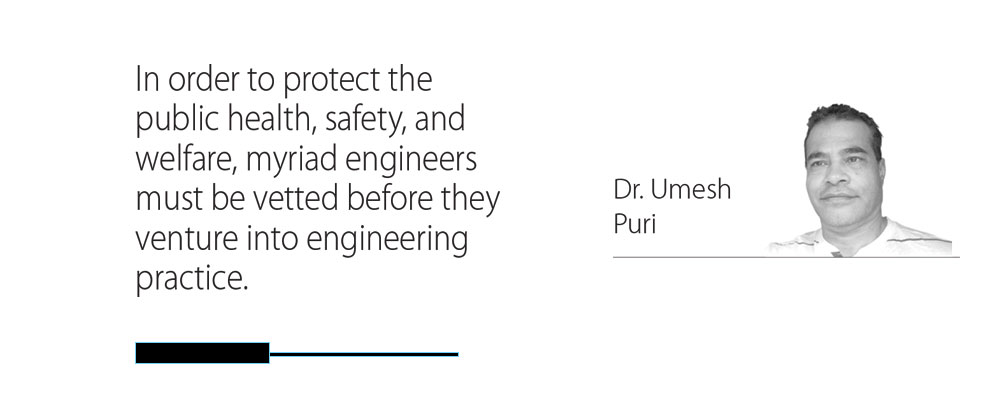- Monday, 28 April 2025
Roadmap For Engineering License Exam
Nepal is unlikely to realise inclusive prosperity unless there is a solid infrastructural development in the country. By the same token, competent and qualified engineers are the heart and soul of any infrastructural project from its inception to accomplishment. Gone are the days in Nepal when engineers were given little or no regard and anyone could take the helm of a project. Skilled engineers are the backbone of a robust infrastructural foundation.
A few decades ago, anyone could work as an engineer without proof of competency. However, the introduction of democracy in 1990 ushered in a growth spurt in engineering colleges and thus the market flooded with nearly 3,000 engineers yearly from local engineering colleges and by the same amount from abroad. This humongous influx of engineers definitely poses challenges to manage the engineering profession in order to deliver quality service to the public. To gauge whether or not those engineers, who earned degrees from a myriad of colleges, measure up to a satisfactory level of competency to practice engineering in Nepal was unequivocally a daunting task.
Public safety
In order to protect the public health, safety, and welfare, myriad engineers must be vetted before they venture into engineering practice. Subsequently, the Nepal Engineering Council (NEC) was conceived under the NEC Act in March, 1999. Through this Act, the NEC has been vested with the statutory authority for the planning, coordinated development and monitoring of engineering profession and education in the country. Yet, the council blatantly lacks a clear roadmap as to how this profession be adeptly advanced and how engineers be licensed to cater to the public at large. The concern here is the licensing system for engineers issued by the NEC. There should be three tiers of licensing system for engineers depending upon their proficiency level: EIT (engineer in training), PE (professional engineer) and SE (structural engineer for advanced structural design only).
The tier that follows is the higher proficiency than the one that precedes. Upon passing a separate exam specifically designed for each tier, one can achieve an EIT, PE or SE license.
Firstly, the EIT exam, also referred to as the fundamentals of engineering (FE) exam, is the first examination that tests knowledge of what college graduates should have mastered during college. The very nature and goal of the EIT exam is to document that one is competent in the “fundamentals of engineering”. These fundamentals should cover a wide range of foundational engineering concepts. From engineering economics to mechanics, material science, computer science, electronics/circuits, engineering design, mathematics, etc. The EIT exam should be designed to span the whole undergraduate coursework in its entirety and be discipline-specific.
Also, the EIT exam should be open to anyone with a four-year degree in engineering or a related field, or currently enrolled in the last year of an accredited engineering degree programme. Upon passing an EIT exam, one is conferred with an EIT certificate. Getting an EIT certificate is one of the most important steps to advance a career in engineering. It demonstrates that one has mastered the fundamentals and is on the road to earning a PE license. It should be mindful that an EIT engineer must work under the tutelage of a PE engineer to gain experience and has no legal right to stamp and seal engineering documents that go out to the public. An EIT engineer is basically an engineer-in-training. Currently, this exam and its purpose is not clearly provisioned by the NEC, and the recently mandated test for engineers by the NEC is not akin to this test.
Secondly, the PE exam tests for a minimum level of competency in a particular engineering discipline. It is designed for engineers who have gained a minimum of post-college work experience (usually four years) under a PE engineer in their chosen engineering discipline. After obtaining a required amount of work experience, an EIT engineer may qualify to take the PE exam. Only upon the successful completion of the PE exam, one is conferred with a PE license. To a client, holding a PE means one has the credentials to earn their trust. To an employer, it signals one’s ability to take on a higher level of responsibility. Only PEs have the legal right to stamp and seal engineering documents that go out to the public. Depending on the industry, a PE engineer should be an absolute minimum requirement to sign and seal engineering plans and offer services to ensure public safety.
By combining their specialied skills with their high standards for ethics and quality assurance, PEs help make us healthier, keep us safer and allow all of us to live better lives than ever before. The NEC’s roadmap is completely oblivious to this test. Thirdly, the SE exam takes the gravity of the licensing exam to a step higher. This is the ultimate and apex test in the licensing system and is applicable only for those who aspire to become the structural designer for specialised structural work like designing hazardous facilities, special occupancy structures (schools or hospitals), large essential facilities, structures with irregularities, tall buildings and long-span bridges with a thorough understanding of seismicity and wind.
The SE exam tests one’s ability to competently practice structural engineering without any limit or restriction. It is specifically designed for engineers who practice structural engineering beyond professional engineers’ scope. Cautiously enough, both PE and SE license must be retained active and current by continuously maintaining and improving skills throughout one’s career with the professional development hour (PDH). The PDH can be earned through participation in the relevant training and seminars. Unfortunately, this test has not been included in the NEC’s noggin. In Nepal, any engineer could undertake the responsibility of a structural engineer, which is flagrantly wrong.
To put it succinctly, going forward the NEC’s licensing system must be clear to address such a tier of tests that are contemporary in engineering practice worldwide. If the NEC is vigilantly honest about its founding principles such as public health, safety, and welfare and concerns about a robust infrastructural development, it has to initiate a brainstorming session with the experienced and all stakeholders to discuss and chart out its roadmap first. Above all, the onus lies in us all to protect the public interest.
(Dr. Puri is a licensed structural engineer in California, USA.)
















